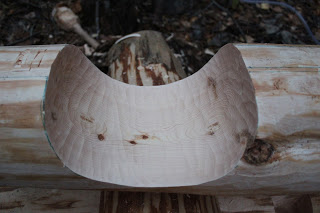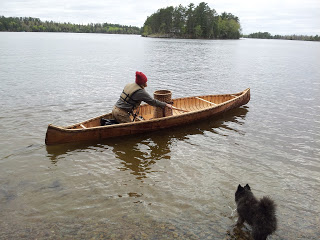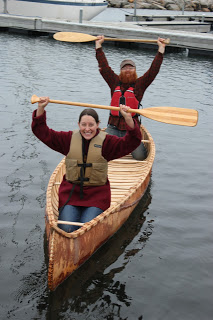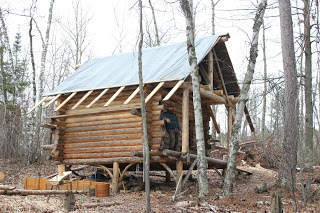
A Modern Day Old-Fashioned Log Cabin
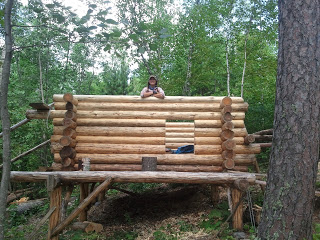
At North House, I frequently have the experience of being inspired. I strike up a conversation with a student or instructor and before long I am hearing about a project or idea that gets my eyes dilating and blood rolling. "I could do that!" I think, and thus begins a new pursuit for a budding crafts-person.
In that spirit, I want to tell you about Lindy and Ashlee's project.
Ashlee stands in their future home.
Lindy carefully carves to the line.
I dream of building myself a cabin someday. I once helped a friend build a small post and beam cabin out of fir poles. It is a fairly common human trait to use the tools and materials available around us that make the job easier and faster. Thus, despite my interest in old-fashioned skills and processes, along with chisels and hammers, we used a chainsaw and circular saw and impact drivers.
Because of this natural human inclination, I am always impressed when I hear about people that eschew modern technology for something simpler.
Detailed joint work on both ends of each log.
Which brings me to one of the inspiring interactions I had this year: the story of Kyle "Lindy" Lind, a 2013 North House intern, and Ashlee Kveton building a cabin - a home - for themselves. And they are building it without chainsaw or power tools of any kind.
A finished scribed wall log.
They are building a full-scribe trapper-style log cabin out of trees from their land, using only hand tools to do the log work. Lest you think they are exaggerating when they say "only hand tools": they started in September 2014, felling red pines with a cross cut saw and ax. These logs are moved by hand then scribed and notched and carved with ax and gouge until they fit perfectly with the log below. They are pulled up the walls with a cross haul - an ingenious rope-based moving system. The floor plan is 11 x 13 feet, and the walls will reach about 9 feet high, with king posts on the gable ends supporting the ridgepole. North House didn't offer this class when Lindy was an intern, so they have taught themselves what they need to know. They are finishing the last of 58 wall logs this week!
A homemade birch bark canoe transports them in summer.
This is their self-built home for now, but will eventually become a sauna when they build a larger home. Located on five acres of red pine and mixed hardwood forest on an island next to the Boundary Waters, they cross the lake by snowshoe and toboggan in the winter and by canoe during the summer. If they need to bring heavy material or equipment in, they use a snowmobile or motorboat. Their water source is at the end of a quarter mile hike, so they look forward to getting a metal roof up to collect rainwater.
"Why?" I can imagine you asking. "Why so basic? So remote? And why with only hand tools?" There are some practical reasons: the building requires few resources to build and will be easy to heat. Using only hand tools is a great opportunity to learn to use an ax efficiently and to learn how to sharpen a crosscut saw. Lindy has spent many years working with chainsaws and mills, so now the quiet of hand tools is very welcome.
Their winter camp while they build their cabin.
Other reasons for building simply go deeper to the source of their life philosophy. This cabin project is inexpensive (so far, they've invested $200 in their home). Avoiding debt gives them invaluable time. "The thing that drives us more than anything is the desire to be free to do the things that we want to do", said Lindy. And ultimately, that is to reconnect with the land beneath their feet and live in the wild. Ashlee and Lindy have a deep passion for wilderness and old-fashioned crafts. "We're out there trying to live simply. We want to accumulate knowledge and experience and wisdom." Lindy then added, "Plus we think it's really cool." Me too, Lindy.
Ashlee and Lindy want to share that deep passion for wilderness and old-fashioned crafts. This land, on the edge of the Boundary Waters, may be a future base out of which they could run traditional skills classes and wilderness trips.
No matter whether this labor of love ends up a cozy winter home, a sauna, or a wilderness skills outfitter, I hope the cabin stands for a long time, inspiring and reminding anyone who sees it that the old ways are still alive, and still so pertinent and precious in our modern world. Keep it up Ashlee and Lindy!
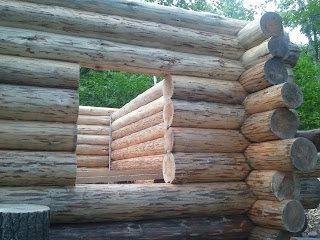
No daylight between those logs!
An update - I just received new photos of the cabin as it currently stands, on November 13. Progress!

